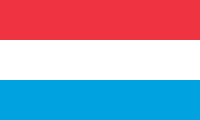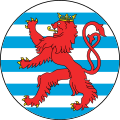Luxembourg flag
| Luxembourg flag | |
|---|---|
 |
|
| Vexillological symbol : |
|
| Aspect ratio: | 1: 2 and 3: 5 |
| Officially accepted: | June 12, 1845 Law of June 23, 1972 Colors established on July 27, 1993 |
The flag of Luxembourg was officially introduced in its current form on June 23, 1972.
description
The national flag is a tricolor and consists of three horizontal stripes of equal size: red at the top, white in the middle and light blue at the bottom.
The current colors are defined as follows according to the Règlement Grand-Ducal of July 27, 1993:
- Red: Pantone 032 c
- Blue: Pantone 299 c
- Gold (only seen in the flag with the Roude Léiw , the red lion): Pantone 116c
history
The colors of Luxembourg have been known since the Middle Ages. In 1240, Count Heinrich V of Luxembourg was the first to carry a white (silver) and blue striped coat of arms and a banner carrying a red crowned lion . Through the resolutions of the Congress of Vienna in 1815, Luxembourg became a Grand Duchy and a member of the German Confederation , but was linked to the Netherlands in personal union through King Wilhelm I. Luxembourg was de facto considered a province of the Kingdom of the Netherlands. During this time, the flag of the Netherlands flied over Luxembourg, which - apart from the nuances of color - has the same appearance as the Luxembourg flag. However, this equality is of a coincidental nature, because the origin of both flags can be traced back to different historical origins. Wilhelm I's rule over Luxembourg was tough; The result was the participation of Luxembourg in the Belgian Revolution in 1830. That year the flag of its present form appeared for the first time: In order to distinguish itself from the flag of the Netherlands, the blue was chosen lighter and finally set on June 12, 1845. The French Revolution may also have had an influence on the choice of the stripe flag . The tricolor and the associated idea of freedom were a popular template for many national flags at the time.
De Roude Léiw
With the expansion of the Moselle and the associated connection of Luxembourg to international inland shipping, the problem of the possibility of confusion between the Luxembourg and Dutch flags increased. Therefore, in the law on national emblems of July 23, 1972, the flag for shipping and aviation ( le pavillon de la batellerie et de l'aviation ) was created.
It consists of ten horizontal stripes of equal size, alternating white and blue; Above, covering all stripes, a gold-crowned, gold-armored and gold-tongued red double-tailed lion . Although Luxembourg has no air force, the Luxembourg cockade is affixed to NATO's AWACS aircraft , all of which are registered in Luxembourg.
It is the flag of the coat of arms image . Because of the figure, the flag is also called de Roude Léiw (the Red Lion) by the Luxembourgers .
The law introducing the Luxembourg Seeschiffsregisters 1990 confirmed this flag as a National for registered in Luxembourg seagoing vessels .
Luxembourg cockade
The "Roude Léiw" as the state flag
On October 5, 2006, the CSV MP Michel Wolter submitted a legislative proposal on his own initiative, which provided for the red-white-blue tricolor to be replaced by the red lion as the official state flag. The proponents of the initiative made the following arguments, among others:
- The tricolor is too similar to the Dutch national flag and the “light blue” border is not visible to outsiders, so it is easily confused with the Dutch.
- The origin of the red lion goes back further than that of the tricolor. The red lion has stood for Luxembourg since the 13th century (see also Luxembourg's coat of arms ), while the tricolor flag comes from the time of the Belgian Revolution and has only been the “de jure” official state flag since 1972.
- The Roude Léiw would have preferred by many Luxembourgers the tricolor. Especially at sporting events such as football or cycling , the Roude Léiw has almost completely displaced the traditional flag.
- The new flag would strengthen the sense of tradition of many Luxembourgers as well as the Luxembourg identity and would also be a commitment to the monarchy. But since the ruling family (= Nassau-Weilburg ) has its own flag, this “argument” can just as easily be viewed as a counter-argument.
- The Roude Léiw represents many Luxembourg for freedom and cohesion, because it one of the main symbols (along with tricolor and Grand Duchess Charlotte) in the resistance against the Nazi occupiers during the Second World War represents.
The opponents of the flag change made the following arguments:
- The red lion is a combative symbol (saying: “Roude Léiw huel se” , in German for example: “Pack them for you red lion”) that arouses nationalistic feelings and thus represents a step backwards towards the nation state.
- The tricolor was the flag of Luxembourg during the Second World War. It was banned by the occupiers and has stood for Luxembourg's will for freedom ever since. Older Luxembourgers in particular feel very attached to the red-white-blue flag.
- The colors of the tricolor stand for the achievements of the French Revolution and the freedom of the people.
- From the point of view of heraldry, the red lion is not suitable as a flag.
- In Belgium , the red lion is already officially used by the province of Luxembourg .
- Replacing the flag would simply be too expensive.
- Until 2006 nobody cared about the whole question.
The discussion sparked heated debates in the press and in politics. For many politicians, however, it was less about the flag itself than about the benefits of such an initiative. Many politicians, including those from the ranks of the CSV, merely stated that there were more important tasks for them than dealing with the appearance of the flag.
In the population, however, the initiative was often received positively or with indifference. Since many politicians did not want to officially deal with the issue, many supporters feared that the project would be dropped and forgotten. Therefore, a group founded the “Initiative Roter Löwe”, which campaigned for a flag change and wanted to advertise the project by means of an internet petition , with the slogan: (in Luxembourgish) Ech sin dofir (in German: I am for it ). The Internet survey showed that a small majority did not want to change their habits. And a study by the University of Luxembourg found that the proponents of the initiative were / are to be located in the ethnic and less educated categories.
In June 2007 Jean-Claude Juncker made it clear that there would be no change of flag with him and his party. Two years after the government submitted its draft reform of the 1972 Law on National Symbols of State, not even a rapporteur has been appointed.
More flags of Luxembourg
literature
- W. Smith, O. Neubecker: The signs of the people and peoples: Our world in flags and flags . Reich Verlag Luzern, 1975, ISBN 3-7243-0115-4
- KH. Hesmer: flags, coats of arms, dates . Bertelsmann Lexikon-Verlag, 1975, ISBN 3-570-01591-2
Web links
- Declaration on the state flag on gouvernement.lu
- Règlement Grand-Ducal of July 27, 1993
- The flag of Luxembourg on FOTW
Individual evidence
- ↑ Règlement grand-ducal du 27 July 1993 précisant la composition chromatique des couleurs du drapeau national luxembourgeois et du pavillon de la batellerie et de l'aviation. - Legilux. Retrieved November 18, 2017 (French).
- ^ Texts coordonné du 16 septembre 1993 de la loi modifiée du 23 juin 1972 sur les emblèmes nationaux. - Legilux. Retrieved November 18, 2017 (French).
- ↑ rh, Red Lion . D'Lëtzebuerger Land , January 6, 2012, p. 4




